Simultaneously increasing stroke rate while reducing load
Based on measurements, it could be shown that a critical process could be safely operated at higher stroke rate.

In a serial process for the production of structural elements, a machine was for years continuously exposed to higher loads due to firmer steel material and higher stroke rate. After the last adjustments, the upper limit seemed to had reached, as major damages to the machine had occured due to massive force peaks.

Together with the serial manufacturer, ConSenses recorded tools- and machine loads at several sroke rates. It turned out that with high propability a local load maximum was reached, beyond which the load per machine cycle could again decrease. Based on this finding, the machine manufacturer was involved to validate if this mechanism could be realistic and if it was reasonable to operate the process in such a "super critical" stroke rate. For the communication between machine manufacturer and serial manufacturer, ConSenses normalized the measured data together with the serial manufacturer. Thus, it was possible exchanging critical data and caring simultaneously for the needed confidentality. This example yielded successful results for all the involved partners.
The responsible personnel at the serial manufacturer understood this approach and added it in their porfolio for improvements.